英语四六级阅读真题常见的短语
四六级阅读真题常见的短语
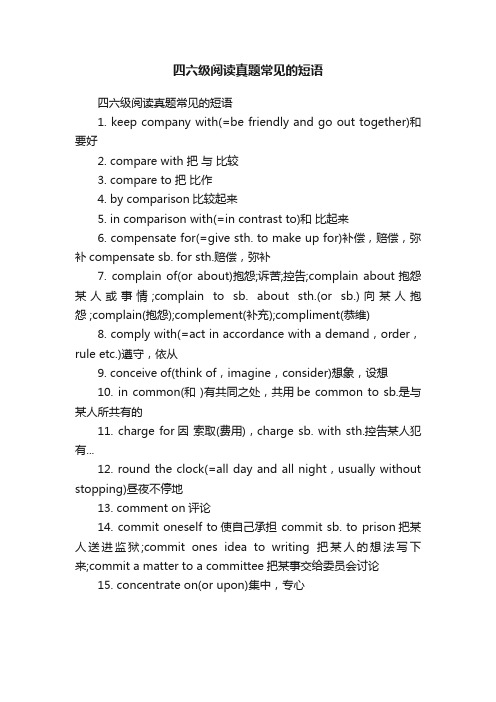
四六级阅读真题常见的短语四六级阅读真题常见的短语1. keep company with(=be friendly and go out together)和要好2. compare with 把与比较3. compare to 把比作4. by comparison比较起来5. in comparison with(=in contrast to)和比起来6. compensate for(=give sth. to make up for)补偿,赔偿,弥补compensate sb. for sth.赔偿,弥补7. complain of(or about)抱怨;诉苦;控告;complain about抱怨某人或事情;complain to sb. about sth.(or sb.)向某人抱怨 ;complain(抱怨);complement(补充);compliment(恭维)8. comply with(=act in accordance with a demand,order,rule etc.)遵守,依从9. conceive of(think of,imagine,consider)想象,设想10. in common(和 )有共同之处,共用be common to sb.是与某人所共有的11. charge for因索取(费用),charge sb. with sth.控告某人犯有...12. round the clock(=all day and all night,usually without stopping)昼夜不停地13. comment on评论14. commit oneself to使自己承担 commit sb. to prison把某人送进监狱;commit ones idea to writing把某人的想法写下来;commit a matter to a committee把某事交给委员会讨论15. concentrate on(or upon)集中,专心。
语六级阅读理解常考词组
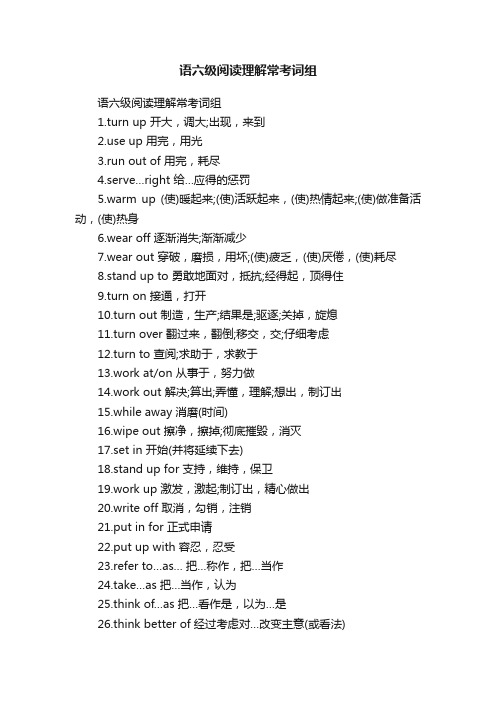
语六级阅读理解常考词组
语六级阅读理解常考词组
1.turn up 开大,调大;出现,来到
e up 用完,用光
3.run out of 用完,耗尽
4.serve…right 给…应得的惩罚
5.warm up (使)暖起来;(使)活跃起来,(使)热情起来;(使)做准备活动,(使)热身
6.wear off 逐渐消失;渐渐减少
7.wear out 穿破,磨损,用坏;(使)疲乏,(使)厌倦,(使)耗尽
8.stand up to 勇敢地面对,抵抗;经得起,顶得住
9.turn on 接通,打开
10.turn out 制造,生产;结果是;驱逐;关掉,旋熄
11.turn over 翻过来,翻倒;移交,交;仔细考虑
12.turn to 查阅;求助于,求教于
13.work at/on 从事于,努力做
14.work out 解决;算出;弄懂,理解;想出,制订出
15.while away 消磨(时间)
16.wipe out 擦净,擦掉;彻底摧毁,消灭
17.set in 开始(并将延续下去)
18.stand up for 支持,维持,保卫
19.work up 激发,激起;制订出,精心做出
20.write off 取消,勾销,注销
21.put in for 正式申请
22.put up with 容忍,忍受
23.refer to…as… 把…称作,把…当作
24.take…as 把…当作,认为
25.think of…as 把…看作是,以为…是
26.think better of 经过考虑对…改变主意(或看法)。
四六级考试中的必考短语和句式精选全文

可编辑修改精选全文完整版1. in advance 提前2.Give priority to 优先…3.Figure out 找出4.Broken down 抛锚5.Twist the meaning 扭曲意思6.Theater剧院/comedy喜剧/romantic story爱情故事/thriller惊悚片/tragedy悲剧/horror movie 恐怖电影7.The shows are not so entertaining. 表演不是那么的有趣。
8.Seasick 晕船/express way 高速公路/9.Sick 恶心10.Paying off 有了回报y off 解雇12.Headlines 头条,新闻报道(我爱KK)13.Economic forum 经济论坛14.For here or to go 在这儿吃还是打包带走;15.I have to watch my weight.小心体重16.They look pretty done.菜已经很熟了。
17.I can’t feel my arm. 我的手麻了。
18.My legs are fallen sleep 我的脚麻了19.Lucid thought 清醒的思维20.To pull strings连在一起,就是通过重要人物,在幕后操纵,在幕后牵线21.Go for registration of a course 注册课程(选课)22.The jacket of the book 书皮23.Sleeping compartment 卧铺24.Do the sight-seeing 观光25.Parking lot 停车场26.Get the prescription filled取药27.Take a year off 休假一年28.It is still a mystery to sb. 对某人而言,这依然是个迷。
29.get upset 变得烦躁30.not really!情况不是这样的31.I think you’d better… 建议句型;32.I am enrolled in… 我参加了…= I take part in…33.I am told that… 听说…(下雨天音乐和巧克力才更配哦.)= I hear that…(peo ple often take chocolate or flowers when they go to dinner at someone’s house.)34.I am afraid that… 恐怕(表示推测)=I think…35.I’d rather… 表达观点36.I made reservations for… 我预定了…37.I would die to have a chance to meet Kevin Kelly. 我愿意不惜一切代价去见KK.38.I got Kevin to do it. 我让kevin去做了。
英语四级阅读理解高频短语
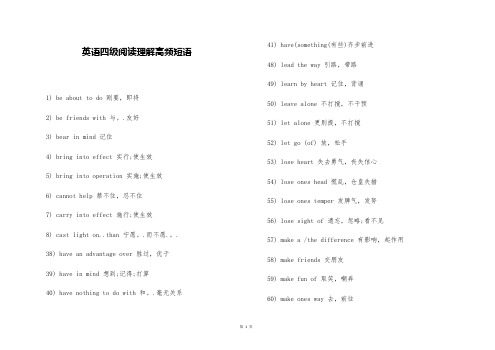
英语四级阅读理解高频短语1) be about to do 刚要,即将2) be friends with 与。
.友好3) bear in mind 记住4) bring into effect 实行;使生效5) bring into operation 实施;使生效6) cannot help 禁不住,忍不住7) carry into effect 施行;使生效8) cast light on..than 宁愿。
.而不愿.。
.38) have an advantage over 胜过,优于39) have in mind 想到;记得;打算40) have nothing to do with 和。
.毫无关系 41) have(something(有些)齐步前进48) lead the way 引路,带路49) learn by heart 记住,背诵50) leave alone 不打搅,不干预51) let alone 更别提,不打搅52) let go (of) 放,松手53) lose heart 失去勇气,丧失信心54) lose ones head 慌乱,仓皇失措55) lose ones temper 发脾气,发努56) lose sight of 遗忘,忽略;看不见57) make a /the difference 有影响,起作用58) make friends 交朋友59) make fun of 取笑,嘲弄60) make ones way 去,前往61) make sense 讲得通,言之有理62) make sure 查明;务必63) make the best of 充分利用64) make the most of 充分利用65) make up ones mind 下决心,打定主意66) make use of 使用,利用67) make way 让路,让出地方68) may as well 还不如,不妨69) never mind 不要紧;不用担忧70) pay attention to 注意71) piece together 拼合72) play a part(in) 起作用,参于73) put into effect 实施;使生效 74) put into operation 实施;使生效75) put into practice 实施;实行76) put to use 使用) see to it that 注意,务必,保证78) see that 注意,务必,保证79) set fire to 使燃烧,点燃80) take...for 把。
英语四六级作文必背短语短句
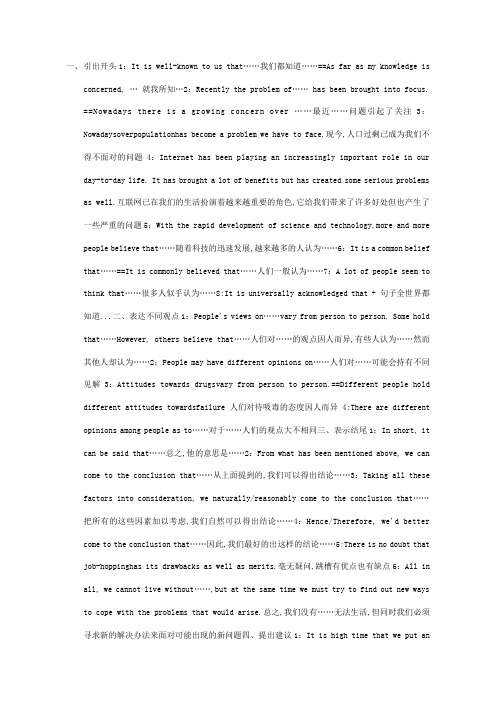
一、引出开头1:It is well-known to us that……我们都知道……==As far as my knowledge isconcerned, … 就我所知…2:Recently the problem of…… has been brought into focus.==Nowadays there is a growing concern over ……最近……问题引起了关注3:Nowadaysoverpopulationhas become a problem we have to face.现今,人口过剩已成为我们不得不面对的问题4:Internet has been playing an increasingly important role in our day-to-day life. It has brought a lot of benefits but has created some serious problems as well.互联网已在我们的生活扮演着越来越重要的角色,它给我们带来了许多好处但也产生了一些严重的问题5:With the rapid development of science and technology,more and more people believe that……随着科技的迅速发展,越来越多的人认为……6:It is a common belief that……==It is commonly believed that……人们一般认为……7:A lot of people seem to think that……很多人似乎认为……8:It is universally acknowledged that + 句子全世界都知道...二、表达不同观点1:People's views on……vary from person to person. Some hold that……However, others believe that……人们对……的观点因人而异,有些人认为……然而其他人却认为……2:People may have different opinions on……人们对……可能会持有不同见解3:Attitudes towards drugsvary from person to person.==Different people hold different attitudes towardsfailure人们对待吸毒的态度因人而异4:There are different opinions among people as to……对于……人们的观点大不相同三、表示结尾1:In short, it can be said that……总之,他的意思是……2:From what has been mentioned above, we can come to the conclusion that……从上面提到的,我们可以得出结论……3:Taking all these factors into consideration, we naturally/reasonably come to the conclusion that……把所有的这些因素加以考虑,我们自然可以得出结论……4:Hence/Therefore, we'd better come to the conclusion that……因此,我们最好的出这样的结论……5:There is no doubt that job-hoppinghas its drawbacks as well as merits.毫无疑问,跳槽有优点也有缺点6:All in all, we cannot live without……,but at the same time we must try to find out new ways to cope with the problems that would arise.总之,我们没有……无法生活,但同时我们必须寻求新的解决办法来面对可能出现的新问题四、提出建议1:It is high time that we put anend to the trend.该是我们停止这一趋势的时候了2:There is no doubt that enough concern must be paid to the problem of……毫无疑问,对……问题应予以足够重视3:Obviously ,if we want to do something … it is essential that……显然,如果我们想要做么事,很重要的是……4:Only in this way can we ……只有这样,我们才能……5:Spare no effort to + V 不遗余力的五、预示后果1:Obviously,if we don't control the problem, the chances are that……will lead us in danger.很明显,如果我们不能控制这一问题,很有可能我们会陷入危险2:No doubt, unless we take effective measures, it is very likely that ……毫无疑问,除非我们采取有效措施,否则我们很可能会……3:It is urgent that immediate measures should be taken to stop the situation很紧迫的是应立即采取措施阻止这一事态的发展六、表示论证1:From my point of view, it is more reasonable to support the first opinion rather than the second.在我看来,支持第一种观点比第二种更有道理2:I cannot entirely agree with the idea that……我无法完全同意这一观点3:As far as I am concerned/In my opinion,……就我来说……4:I sincerely believe that……==I am greatly convinced that 子句.我真诚地相信……5:Finally, to speak frankly, there is also a more practical reason why ……最后,坦率地说,还有另外一个实际的原因……七、给出原因1:The reason why + 句子 ~~~ is that + 句子 ...的原因是... 2:This phenomenon exists for a number of reasons .First,…….Second,…….Third,……;这一现象存在有很多原因的,第一……第二……第三……3:For one thing,…… For another thing,…… ==On the one hand,……On the other hand……一方面……另一方面……4:I quite agree with the statement that……The reasons are chiefly as follows.我十分赞同这一论述,即……;其主要原因如下;八、列出解决办法和批判错误观点做法1:The best way to solve the troubles is……解决这些麻烦的最好办法是……2:As far as something is concerned,……就某事而言,……3;It is obvious that……很显然……4:It may be true that……but it doesn't mean that……可能……是对的,但这并不意味着……5;It is natural to believe that……but we shouldn't ignore that……认为……是自然的,但我们不应忽视……6:There is no evidence to suggest that……没有证据表明……九、表示好处和坏处1:It has the following advantages.它有如下优势2:It is beneficial/harmful to us.==It is of great benefit/harm to us.它对我们有益处3:Ithas more disadvantages than advantage.他有很多不足之处十、表示重要、方便、可能1:It is importantnecessary/difficult/convenient/possiblefor sb to do sth.对于某人做……是……2:It plays an important role in our life.十一、采取措施1:We should take some effective measures.我们应该采取有效措施2:We should try our best to overcome/conquer the difficulties.我们应该尽最大努力去克服困难3:We should do our utmost in doing sth.我们应该尽力去做……4:We should solve the problems that we are confronted/faced with.我们应该解决我们面临的困难十二、显示变化1:Some changes have taken place in the past five years.过去五年发生了很多变化2:Great changes will certainly be produced in the international communications.在国际交流中理所当然会发生很多大的变化3:It has increased/decreased from…to…他已经从…增加/减少到…4:The output of July in this factory increased by 15%.这个工厂7月份产量以增加了15%十三、表明事实现状1;We cannot ignore the fact that……我们不能忽略这个事实……2:No one can deny the fact that……没人能否认这个事实……3:This is a phenomenon that many people are interested in.4:be closely related to ~~ 与...息息相关十四、进行比较1:Compared with A,B……与A比较,B……2;I prefer to read rather than watch TV.十五、常用英语谚语1:Actions speak louder than words.事实胜于雄辩2:All is not gold that glitters.发光的未必都是金子3:All roads lead to Rome.条条大路通罗马4:A good beginning is half done.良好的开端是成功的一半5:Every advantage has its disadvantage有利必有弊6:A miss is as good asa mile.失之毫厘,差之千里7:Failure is the mother of success.失败是成功之母8:Industryis the parent of success.勤奋是成功之母9:It is never too old to learn.活到老,学到老10:Knowledge is power.知识就是力量11:Nothing in the world is difficult for one who setsh i s m i n d t o i t.世上无难事,只怕有心人好强的英语系某人的整理~~看了这些想不过四六级都难~~~ 2009-07-24 20:00 | 分类: 英语四六级写作25个加分句型一、~~~ the + ~ est + 名词 + that + 主词 + have ever + seen known/heard/had/read, etc ~~~ the most + 形容词 + 名词 + that + 主词 + have ever + seen known/heard/had/read, etc 例句:Helen is the most beautiful girl that I have ever seen.海伦是我所看过最美丽的女孩;Mr. Chang is the kindest teacher that I have ever had.张老师是我曾经遇到最仁慈的教师;二、Nothing is + ~~~ er than to + V Nothing is + more + 形容词 + than to + V例句:Nothing is more important than to receive education.没有比接受教育更重要的事;三、~~~ cannot emphasize the importance of ~~~ too much.再怎么强调...的重要性也不为过; 例句:We cannot emphasize the importance of protecting our eyes too much.我们再怎么强调保护眼睛的重要性也不为过;四、There is no denying that + S + V ...不可否认的...例句:There is no denying that the qualities of our living have gone from bad to worse. 不可否认的,我们的生活品质已经每况愈下;五、It is universally acknowledged that + 句子~~ 全世界都知道...例句:It is universally acknowledged that trees are indispensable to us.全世界都知道树木对我们是不可或缺的;六、There is no doubt that + 句子~~ 毫无疑问的...例句:There is no doubt that our educational system leaves something to be desired.毫无疑问的我们的教育制度令人不满意;七、An advantage of ~~~ is that + 句子 ...的优点是...例句:An advantage of using the solar energy is that it won’t create produce any pollution. 使用太阳能的优点是它不会制造任何污染;八、The reason why + 句子 ~~~ is that + 句子 ...的原因是...例句:The reason why we have to grow trees is that they can provide us with fresh air./ The reason why we have to grow trees is that they can supply fresh air for us.我们必须种树的原因是它们能供应我们新鲜的空气;九、So + 形容词 + be + 主词 + that + 句子如此...以致于...例句:So precious is time that we can’t afford to waste it.时间是如此珍贵,我们经不起浪费它;十、Adj + as + Subject主词+ be, S + V~~~ 虽然...例句:Rich as our country is, the qualities of our living are by no means satisfactory. {by no means = in no way = on no account 一点也不}虽然我们的国家富有,我们的生活品质绝对令人不满意;十一、The + ~er + S + V,~~~the + ~er + S + V ~~~The + more + Adj + S + V,~~~the + more + Adj + S + V~~~愈...愈...例句:The harder you work, the more progress you make.你愈努力,你愈进步;The more books we read, the more learned we become.我们书读愈多,我们愈有学问;十二、By +Ving, ~~ can ~~ 借着...,..能够..例句:By taking exercise, we can always stay healthy.借着做运动,我们能够始终保持健康;十三、~~~ enable + Object受词+ to + V ..使..能够..例句:Listening to music enable us to feel relaxed.听音乐使我们能够感觉轻松;十四、On no account can we + V ~~~ 我们绝对不能...例句:On no account can we ignore the value of knowledge.我们绝对不能忽略知识的价值;十五、It is time + S + 过去式该是...的时候了例句:It is time the authorities concerned took proper steps to solve the traffic problems. 该是有关当局采取适当的措施来解决交通问题的时候了;十六、Those who ~~~ ...的人...例句:Those who violate traffic regulations should be punished.违反交通规定的人应该受处罚;十七、There is no one but ~~~ 没有人不...例句:There is no one but longs to go to college.没有人不渴望上大学;十八、be + forced/compelled/obliged + to + V 不得不...例句:Since the examination is around the corner, I am compelled to give up doing sports. 既然考试迫在眉睫,我不得不放弃做运动;十九、It is conceivable that + 句子可想而知的It is obvious that + 句子明显的It is apparent that + 句子显然的例句:It is conceivable that knowledge plays an important role in our life.可想而知,知识在我们的一生中扮演一个重要的角色;二十、That is the reason why ~~~ 那就是...的原因例句:Summer is sultry. That is the reason why I don’t like it.夏天很燠热;那就是我不喜欢它的原因;二十一、For the past + 时间,S + 现在完成式...过去...年来,...一直...例句:For the past two years, I have been busy preparing for the examination.过去两年来,我一直忙着准备考试;二十二、Since + S + 过去式,S + 现在完成式;例句:Since he went to senior high school, he has worked very hard.自从他上高中,他一直很用功;二十三、It pays to + V ~~~ ...是值得的;例句:It pays to help others.帮助别人是值得的;二十四、be based on 以...为基础例句:The progress of thee society is based on harmony.社会的进步是以和谐为基础的;二十五、Spare no effort to + V 不遗余力的例句:We should spare no effort to beautify our environment.我们应该不遗余力的美化我们的环境;还有下面这些是我正在读的一些原版书里的好句子You can never have too much sky. You can fall asleep and wake up drunk on sky, and sky can keep you safe when you are sad. Here there is too much sadness and not enough sky. Butterflies too are few and so are flowers and most things that are beautiful. Still, we take what we can get and make the best of ;你永远不能拥有太多的天空;你可以在天空下睡去,醒来又沉醉;在你忧伤的时候,天空会给你安慰;可是忧伤太多,天空不够,蝴蝶不够,花儿也不够;大多美好的东西都不够;于是,我们去我们所能,好好的享用;——芒果街上的小屋IT is a truth universally acknowledged, that a single man in possession of a good fortune must be in want of a wife.这是一条举世皆知的真理,那就是...套进去^^——傲慢与偏见There is no royal road to science. ......路上无坦途;——马克思;有的时候一个很好的单词作用也是非常强大的哦~可以替换以下哈~这些都是传说中的big words~1. important =crucial extremely important,significantamount or effect large enough to be important=universal, ubiquitousif something is ubiquitous, it seems to be everywhere=ampleenough and usually extra, plentifulenough for people's needs and wants1=adhere, clinghold on something tightly1=ignore.difference: neglect means someone has not paid enough attention to something; ignore means no attention.=adjacenttwothings next to each other, adjointhe same as adjacent'=wooman woos woman, old-fashioned, seekif you seek sth, you try to obtain it. FORMAL=preciseprecise is exact and accurate in all details, exactcorrect in every detail=obscureunknown or known by only a few people=peak, summit=rival, opponentespecially in sports and politics1=condemnif you condemn something, you say it is very bad and unacceptable=perspective, standpointmeans looking at an event or situation in a particular way=prestigedescribe those who are admired, reputation=erectyou can erect something as buildings, FORMAL, establish=humiliatedo something or say something which makespeople feel ashamed or stupid=grumble complain something in a bad-tempered way=radical very important and great in degree, fundamental=alleviate alleviate means you make pain or sufferings less intense or severe=coerces intocoerce means you make someone do something s/he does not want to,compel=magnifymagnify means make something larger than it really is=intricateif something is intricate, it often has many small parts and details23. Lonely=solitary if someone is solitary, there is no one near him/her=minusculevery small, minute, V. A. B8 Q6 w, p$ S=extolstronger than praise, complimentpolite and political=assiduoussomeone who is assiduous works hard or does things very thoroughly=arduous if something is arduous, it is difficult and tiring, and involves a lot of efforts soil=barren, infertileused to describe the soil is so poor that plants cannot be planted on it=brittle, vulnerablesomeone who is vulnerable is easily hurt emotionally or physically+ =demonstrate to demonstrate a fact means tp make it clear to people.=massivelarge in size, quantity, or extent, colossaluse this word, you emphasize something’s large, tremendousINFORMAL+=shunif someone shuns something, s/he deliberately avoid that something or keep away from it.% -0 B/ X: V=impartialsomeone who is impartial is able to give a fair opinion or decision on something.0 U V0 e/ a" h0 L8 ~=assault physically attack someone, assail attack violently=abhorabhor means you hate something to a extreme extent for moral reasons, loathedislike very much=devastate it means damage something very badly, or utterly destroy it.=invariablythe same as always, but better than always4=perpetuala perpetual state never changes, immutablesomething immutable will never change or be changed=startleit means surprise you slightly, astoundsurprise you to a large degree,astonishthe same as astound=zeal a great enthusiasm, fervency sincere and enthusiasm=tranquilcalm and peaceful, serenecalm and quiet=exorbitantit means too expensive that it should be=lavishimpressive and very expensive, sumptuousgrand and very expensive=tediousif you describe something tedious, you mean it is boring and frustrating=esteemif you esteem someone, you respect and admire him/her. FORMAL=fretif you fret about something, you worry about it=chillyunpleasantly cold, icyextremely cold=boilingvery hot=perilousvery dangerous, hazardousdangerous, especially to people's safety and health/ { =currently=uniquethe only one of its kind, distinctive;=ceaseif something ceases, it stops happening or existing=componentthe components of something are the parts that it is made of h=consequencethe results or effects of something=apparent, manifest=derived fromcan see or notice them very easily=fairly=lamentablevery uncomfortable and disappointing=domaina particular field of thought, activities or interest=emergecome into existence=entirethe whole of something8=moistslightly wet, dampslightly wet, humidvery damp and hot=erroneousincorrect or partly correct=formidable=convertchange into another form=quintessentialthis word means represent a typical example of something=cautiousvery careful in order to avoid danger, prudentcareful andsensible=capacity, capabilitythe same as ability=eccentricif some one is eccentric, s/he behaves in a strange way, orhis/her opinion is different from most people=affluentif you are affluent, you have a lot of money= utilize the same as use=skepticalif you are skeptical about something, you have doubts on it.=gratify if you are gratified by something, it gives you pleasure andsatisfaction=fleeting, ephemeralif something is ephemeral, it lasts a short time=fellowship=enragedextremely angry=malodorousused to describe an unpleasant smell=hideousif something is hideous, it is very ugly or unattractive=appealingpleasing and attractive, absorbingsomething absorbing canattract you a great deal=miscellaneousa miscellaneous groups consists of many different kinds of things=disarray, chaos=franticallyused to describe someone who behaves in a wild and uncontrolled way=meteoricATTENTION: meteoric is only used to describe someone achieves success quickly=mundanevery ordinary and not at interesting or unusual=notwithstandingFORMAL=optimalused to describe the best level something can achieve/=acutesevere and intense=inconceivableifyou deem something inconceivable, you think it very unlike to happen ^=perplexsomething perplex someone means it confuses and worries him/her because he/she does not understand it=avenueaway of getting something done=distinguishedused to describe people who are successful in their career =archaicextremely old and extremely old-fashioned=embellishembellish means make something look more attractive via decorating it with something else/=feasibleif something is feasible, it can be done, made or achieved=consequently, accordingly=infrequent doesn’t happen often=rapaciousgreedy and selfish以下是其他的搜集英语写作常用句型一段首句1. 关于……人们有不同的观点;一些人认为……There are different opinions among people as to ____ .Somepeople suggest that ____.2. 俗话说常言道……,它是我们前辈的经历,但是,即使在今天,它在许多场合仍然适用;There is an old saying______. Its the experience of ourforefathers,however,it is correct in many cases eventoday.3. 现在,……,它们给我们的日常生活带来了许多危害;首先,……;其次,……;更为糟糕的是……;Today, ____, which have brought a lot of harms in our dailylife. First, ____ Second,____. What makes things worse isthat______.4. 现在,……很普遍,许多人喜欢……,因为……,另外而且……;Nowadays,it is common to ______. Many people like ______because ______. Besides,______.5. 任何事物都是有两面性,……也不例外;它既有有利的一面,也有不利的一面;Everything has two sides and ______ is not an exception,ithas both advantages and disadvantages.6. 关于……人们的观点各不相同,一些人认为说……,在他们看来,……People’s opinions about ______ vary from person to person. Some people say that them,_____.7. 人类正面临着一个严重的问题……,这个问题变得越来越严重; Man is now facing a big problem ______ which is becoming more and more serious.8. ……已成为人的关注的热门话题,特别是在年青人当中,将引发激烈的辩论;______ has become a hot topic among people,especiallyamong the young and heated debates are right on their way.9. ……在我们的日常生活中起着越来越重要的作用,它给我们带来了许多好处,但同时也引发一些严重的问题;______ has been playing an increasingly important role in our day-to-day has brought us a lot ofbenefits but has created some serious problems as well.10. 根据图表/数字/统计数字/表格中的百分比/图表/条形图/成形图可以看出……;很显然……,但是为什么呢According to the figure/number/statistics/percentages inthe /chart/bar graph/line/graph,it can be seen that______ while. Obviously,______,but why二中间段落句1. 相反,有一些人赞成……,他们相信……,而且,他们认为……;On the contrary,there are some people in favor ofthe same time,they say____.2. 但是,我认为这不是解决……的好方法,比如……;最糟糕的是……;But I dont think it is a very good way to solveexample, of all,___.3. ……对我们国家的发展和建设是必不可少的,也是非常重要的;首先,……;而且……,最重要的是……______is necessary and important to our countrys development and construction. First,more, important of all,______.4. 有几个可供我们采纳的方法;首先,我们可以……;There are several measures for us to adopt. First, wecan______5. 面临……,我们应该采取一系列行之有效的方法来……;一方面……,另一方面,Confronted with______,we should take a series of effective measures to______. For one thing,______For another,______ 6. 早就应该拿出行动了;比如说……,另外……;所有这些方法肯定会……;It is high time that something was done about it. For example. addition. these measureswill certainly______.7. 为什么……第一个原因是……;第二个原因是……;第三个原因是……;总的来说,……的主要原因是由于……Why______ The first reason is that secondreason is third is all this, the main cause of ______due to ______. 8. 然而,正如任何事物都有好坏两个方面一样,……也有它的不利的一面,象……; However, just like everything has both its good and bad sides, ______also has its own disadvantages, such as ______. 9. 尽管如此,我相信……更有利; Nonetheless, I believe that ______is more advantageous.。
英语四六级,阅读理解高频短语72个,你背过多少
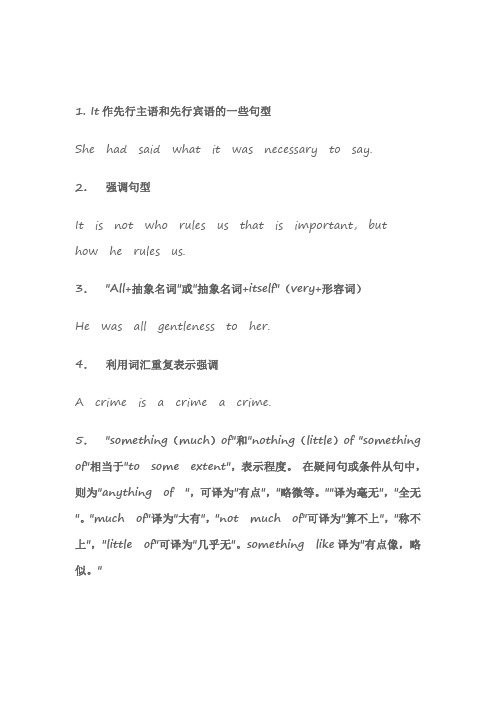
1.It作先行主语和先行宾语的一些句型She had said what it was necessary to say.2.强调句型It is not who rules us that is important,but how he rules us.3."All+抽象名词"或"抽象名词+itself"(very+形容词)He was all gentleness to her.4.利用词汇重复表示强调A crime is a crime a crime.5."something(much)of"和"nothing(little)of"something of"相当于"to some extent",表示程度。
在疑问句或条件从句中,则为"anything of",可译为"有点","略微等。
""译为毫无","全无"。
"much of"译为"大有","not much of"可译为"算不上","称不上","little of"可译为"几乎无"。
something like译为"有点像,略似。
"They say that he had no university education,but he seems to be something of a scholar.6.同格名词修饰是指of前后的两个名词都指同一个人或物,"of"以及它前面的名词构一个形容词短语,以修饰"of"后面的那个名词。
如"her old sharper of a father",可译为:"她那骗子般的父亲"。
英语四级考试阅读理解常考短语
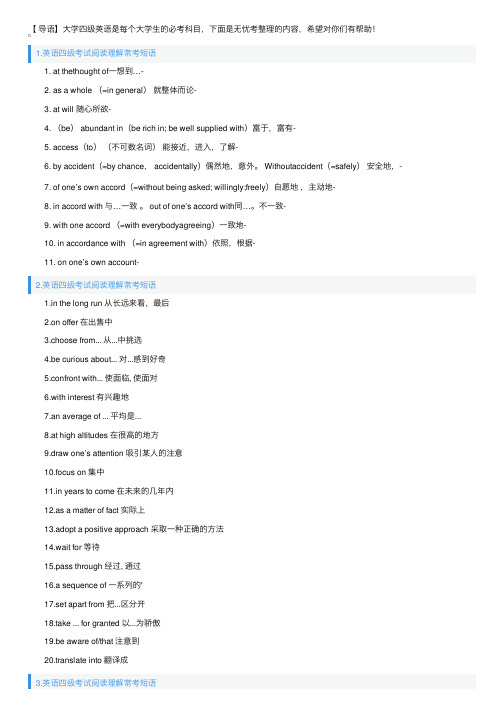
【导语】⼤学四级英语是每个⼤学⽣的必考科⽬,下⾯是⽆忧考整理的内容,希望对你们有帮助!1.英语四级考试阅读理解常考短语 1. at thethought of⼀想到…- 2. as a whole (=in general)就整体⽽论- 3. at will 随⼼所欲- 4. (be) abundant in(be rich in; be well supplied with)富于,富有- 5. access(to)(不可数名词)能接近,进⼊,了解- 6. by accident(=by chance, accidentally)偶然地,意外。
Withoutaccident(=safely)安全地,- 7. of one’s own accord(=without being asked; willingly;freely)⾃愿地,主动地- 8. in accord with 与…⼀致。
out of one’s accord with同…。
不⼀致- 9. with one accord (=with everybodyagreeing)⼀致地- 10. in accordance with (=in agreement with)依照,根据- 11. on one’s own account-2.英语四级考试阅读理解常考短语 1.in the long run 从长远来看,最后 2.on offer 在出售中 3.choose from... 从...中挑选 4.be curious about... 对...感到好奇 5.confront with... 使⾯临, 使⾯对 6.with interest 有兴趣地 7.an average of ... 平均是... 8.at high altitudes 在很⾼的地⽅ 9.draw one’s attention 吸引某⼈的注意 10.focus on 集中 11.in years to come 在未来的⼏年内 12.as a matter of fact 实际上 13.adopt a positive approach 采取⼀种正确的⽅法 14.wait for 等待 15.pass through 经过, 通过 16.a sequence of ⼀系列的' 17.set apart from 把...区分开 18.take ... for granted 以...为骄傲 19.be aware of/that 注意到 20.translate into 翻译成3.英语四级考试阅读理解常考短语 1、alterv.改变,改动,变更 2、burstvi.,n.突然发⽣,爆裂 3、disposevi.除掉;处置;解决;处理(of) 4、blastn.爆炸;⽓流vi.炸,炸掉 5、consumev.消耗,耗尽 6、splitv.劈开;割裂;分裂a.裂开的 7、spitv.吐(唾液等);唾弃 8、spillv.溢出,溅出,倒出 9、slipv.滑动,滑落;忽略 10、slidev.滑动,滑落n.滑动;4滑⾯;幻灯⽚ 11、bacterian.细菌 12、breedn.种,品种v.繁殖,产仔 13、budgetn.预算v.编预算,作安排 14、candidaten.候选⼈ 15、campusn.校园 16、liberala.慷慨的;丰富的;⾃由的4.英语四级考试阅读理解常考短语 be all ears 全神贯注地倾听着 give ear to 听,倾听 give one's ears 不惜任何代价(要) early or late 迟早 keep early hours 早睡早起 earn one's living 谋⽣ on earth 在世界上;究竟,到底 at ease ⾃由⾃在;舒适,舒坦 take it easy 不紧张;放松;松懈 eat of 吃…中的⼀部分 eat off 吃掉,腐烂掉 eat up 吃完,吃光;耗尽 bring into effect 实⾏,实现,实施 come into effect 开始⽣效,开始实⾏ in effect 实际上;正实⾏中 take effect (药等)见效 either...or 或…或,不是…就是 or else 否则,要不然 employ oneself in 使忙于,使从事于 be out of employment 失业 empty of 缺乏,⽆ be at the end 到尽头,达限度 come to an end 告终,结束;完结 end in 以…为结果 end off 结束 end up 结束,告终;竖着5.英语四级考试阅读理解常考短语 end up with 以…⽽结束 in the end 最后,终于 on end 连续地;竖着 to the end of time 永远 world without end 永远,永久地 engaged in 使从事于,使忙于 engaged with 与…有事商谈 enjoy oneself[in'd-0i w3n'self]过得快活;玩得⾼兴 ensure sb. against 保护某⼈免受… enter into 进⼊;参加;开始从事 enter upon 开始,着⼿ be equal to 等于,相当于 equip with 装备,配备 by error 错误地 in error 弄错了的;错误地 even if 即使,纵然 at all events ⽆论如何 even now 即使在现在 in any event 不管怎样,⽆论如何 in the event of 如果…发⽣,万⼀ for ever 永远 for example 例如 except for 除…之外 go to excess ⾛极端 in excess of 超过。
英语四级的阅读理解常见词汇与短语
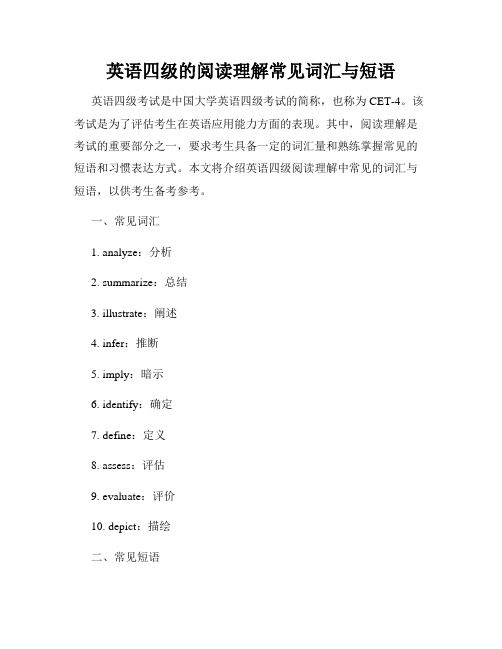
英语四级的阅读理解常见词汇与短语英语四级考试是中国大学英语四级考试的简称,也称为CET-4。
该考试是为了评估考生在英语应用能力方面的表现。
其中,阅读理解是考试的重要部分之一,要求考生具备一定的词汇量和熟练掌握常见的短语和习惯表达方式。
本文将介绍英语四级阅读理解中常见的词汇与短语,以供考生备考参考。
一、常见词汇1. analyze:分析2. summarize:总结3. illustrate:阐述4. infer:推断5. imply:暗示6. identify:确定7. define:定义8. assess:评估9. evaluate:评价10. depict:描绘二、常见短语1. in terms of:从...方面来看2. as a result of:由于3. be based on:以...为基础4. take into account:考虑到5. be equivalent to:相当于6. be associated with:与...相关7. be characterized by:以...为特征8. be consistent with:与...一致9. be independent of:独立于10. be contrary to:与...相反三、常用习惯表达方式1. on the one hand...on the other hand:一方面...另一方面2. in addition:此外3. moreover:而且4. on the contrary:相反地5. as a matter of fact:事实上6. in conclusion:总之7. in summary:概括地说8. it is worth mentioning that:值得一提的是9. it can be concluded that:可以得出结论10. as is often the case:常常是这样四、注意事项在阅读理解中遇到生词时,应采取积极的词汇记忆方法,例如使用词汇卡片、创建词汇表等以便于加以记忆。
